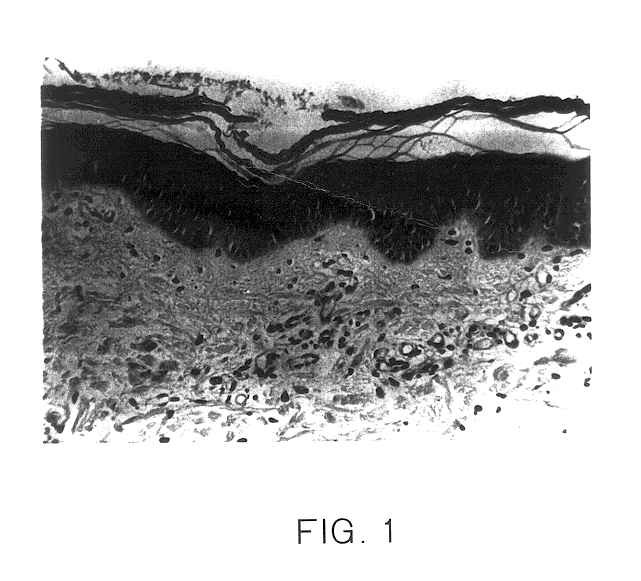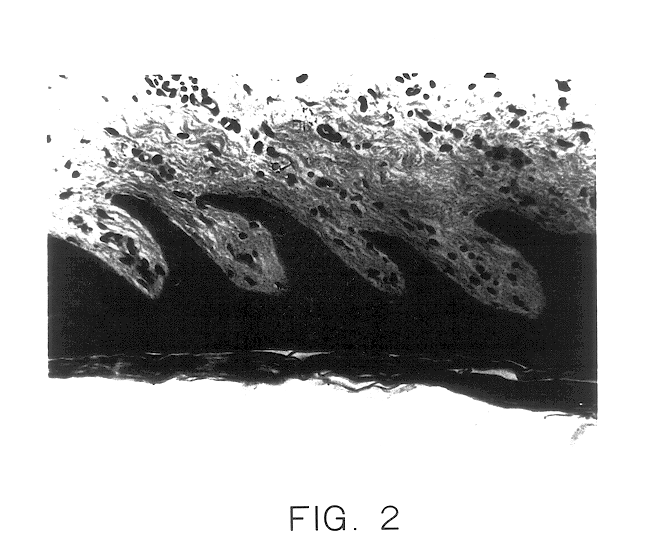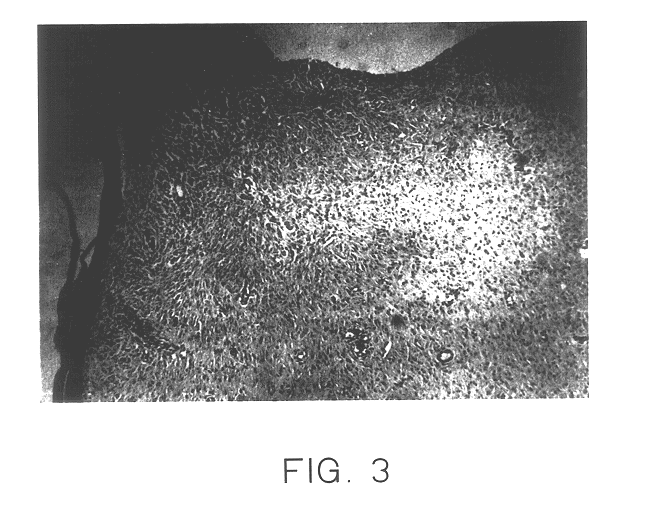Non-viable keratinocyte cell composition or lysate for promoting wound healing
a keratinocyte and non-viable technology, applied in the field of non-viable keratinocyte cell composition or lysate for promoting wound healing, can solve the problems of insufficient amount to cover the entire wound surface, risk of transferring pathogens such as human immunodeficiency virus, hepatitis b virus, cytomegalovirus, from the skin donor to the acceptor patient,
- Summary
- Abstract
- Description
- Claims
- Application Information
AI Technical Summary
Problems solved by technology
Method used
Image
Examples
example 1
Skin Source and Isolation of Keratinocytes
Human keratinocytes were isolated from surgical skin specimens (foreskin, mammoplasties, abdominal skin, and other locations on the body), and from cadaver skin.
Skin was removed with a dermatome at a thickness up to 1 mm. Thicker pieces of skin, sometimes containing hypodermis, were used as well. The skin was immediately placed in phosphate buffered saline (PBS): 8 g NaCl, 0.2 g KCl, 3.1 g Na.sub.2 HPO.sub.4.12H.sub.2 O, 0.2 g KH.sub.2 PO.sub.4 in MILLI-Q.RTM. water to 1 L; pH 7.4) and kept at 4.degree. C. Specimens were then transferred to the culture lab within 4 h. The skin was rinsed extensively with PBS containing 100 U / ml penicillin, and 100 mg / ml streptomycin. If necessary, skin samples were stored at 4.degree. C. in solution A, which is an isotonic buffered solution containing 30 mM Hepes, 10 mM glucose, 3 mM KCl, 130 mM NaCl, 1 mM Na.sub.2 HPO.sub.4.12H.sub.2 O and 3.3 nM phenol red. Thin pieces of skin may be stored for about 16 h,...
example ii
Role of EGF, Cholera Toxin, Hydrocortisone, and Insulin in Feeder Layer-free Keratinocyte Grown In Vitro
Summary
Epidermal growth factor (EGF) is necessary to induce rapid proliferation of human keratinocytes. However, a low yield of attached keratinocytes is seen when EGF alone is present in the medium. Cholera toxin (CT) allows a high yield of attached and spread keratinocytes. On the other hand, growth arrest is seen when CT alone is present in the culture medium.
Hydrocortisone induces keratinocyte proliferation but is less potent than EGF. Insulin has a beneficial effect on keratinocytes, although its effect is more important when the medium contains EGF and cholera toxin, or EGF and hydrocortisone, than when EGF, cholera toxin, and hydrocortisone are present, particularly at the preferred concentrations.
The optimal concentrations of EGF, hydrocortisone, and cholera toxin in the culture medium are respectively for instance 10 ng, 0.13 .mu.g and 9 ng per ml. Insulin may be added, p...
PUM
| Property | Measurement | Unit |
|---|---|---|
| temperature | aaaaa | aaaaa |
| temperature | aaaaa | aaaaa |
| temperature | aaaaa | aaaaa |
Abstract
Description
Claims
Application Information
 Login to View More
Login to View More - R&D
- Intellectual Property
- Life Sciences
- Materials
- Tech Scout
- Unparalleled Data Quality
- Higher Quality Content
- 60% Fewer Hallucinations
Browse by: Latest US Patents, China's latest patents, Technical Efficacy Thesaurus, Application Domain, Technology Topic, Popular Technical Reports.
© 2025 PatSnap. All rights reserved.Legal|Privacy policy|Modern Slavery Act Transparency Statement|Sitemap|About US| Contact US: help@patsnap.com



